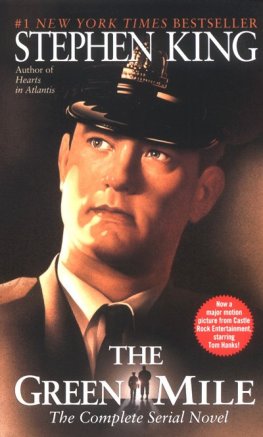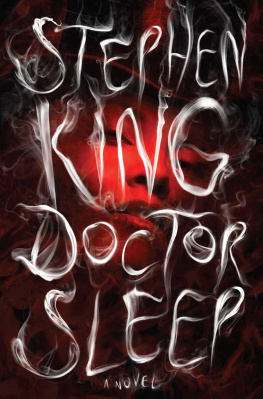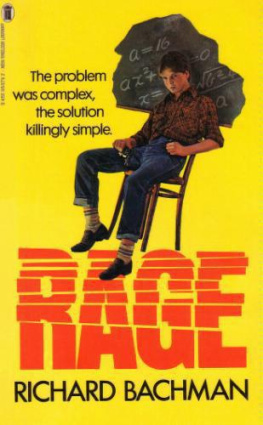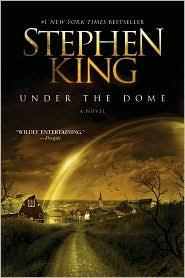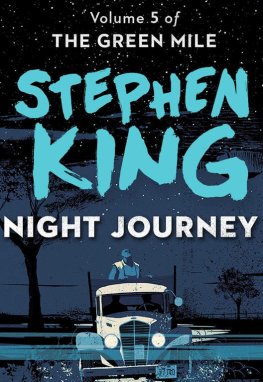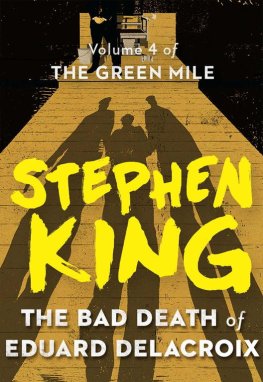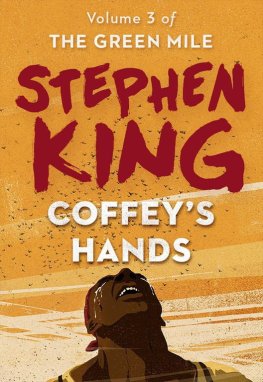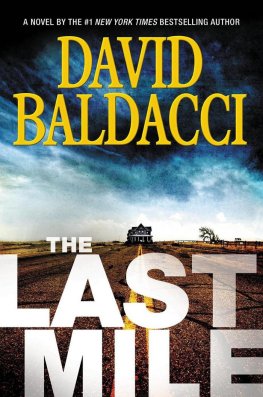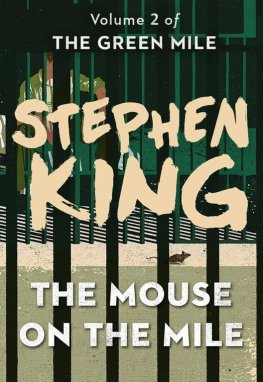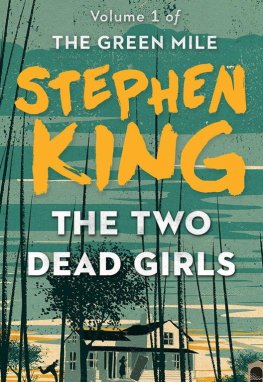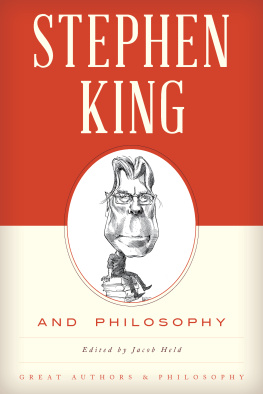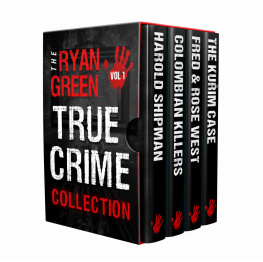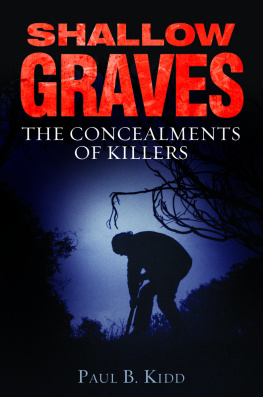The Green Mile
by Stephen King
I go through cycles of insomniaa fact that won't surprise people who've read the novel chronicling the adventures of Ralph Robertsand so I try to keep a story handy for those nights when sleep won't come. I tell these to myself as I lie in the dark, writing them in my mind just as I would on a typewriter or a word processor, often going back and changing words, adding thoughts, deleting clauses, making up the dialogue. Each night I start over at the beginning, getting a little further before I drop off. By the fifth or sixth night I've usually got whole chunks of prose memorized. This probably sounds a little nuts, but it's soothing... and as a time-passer, it beats the shit out of counting sheep.
These stories eventually wear out, just as a book will after it's been read over and over again. ("Throw it out and buy a new one, Stephen," my mother would sometimes say, turning an irritable eye on a well-loved comic book or paperback. "That one's read to rags.") Then it's time to look for a new one, and during my bouts of sleeplessness, I hope a new one will come soon, because sleepless hours are long hours.
In 1992 or '93, I was working on a bedtime story called "What Tricks Your Eye." It was about a man on death rowa huge black manwho develops an interest in sleight-of-hand as the date of his execution draws near. The story was to be told in the first person, by an old trusty who wheeled a cart of books through the cell blocks, and who also sold cigarettes, novelties, and little notions like hair tonic and airplanes made out of waxed paper. At the end of the story, just before his execution, I wanted the huge prisoner, Luke Coffey, to make himself disappear.
It was a good idea, but the story wouldn't work for me. I tried it a hundred different ways, it seemed, and it still wouldn't work for me. I gave the narrator a pet mouse that rode on his trolley, thinking that might help matters, but it didn't. The best part of it was the opening: "This happened in 1932, when the state pen was still in Evans Notch... and the electric chair, of coursewhat the inmates called Old Sparky." That worked, it seemed to me; nothing else about it did. Eventually I discarded Luke Coffey and his disappearing coins in favor of a tale about a planet where people for some reason turned into cannibals when it rained... and I still like that one, so hands off, y'hear?
Then, about a year and a half later, the death-row idea recurred to me, only this time with a different slantsuppose, I thought, the big guy was a healer of some sort instead of an aspiring magician, a simpleton condemned for murders that he not only did not commit but had tried to reverse?
That story was too good to play with at bedtime, I decided, although I did begin it in the dark, resurrecting the opening paragraph almost word for word, and working out the first chapter in my mind before beginning to write. The narrator became a death-house guard instead of a trusty, Luke Coffey became John Coffey (with a tip of the chapeau to William Faulkner, whose Christ-figure is Joe Christmas), and the mouse became... well, Mr. Jingles.
It was a good story, I knew that from the first, but it was a tremendously hard story to write. Other things were going on in my life that seemed easierthe teleplay for The Shining miniseries was oneand I was holding onto The Green Mile by my fingernails. I felt as if I were creating a world almost from scratch, as I knew almost nothing about life on death row in the border South during the Depression. Research can remedy that, of course, but I thought that research might kill the fragile sense of wonder I had found in my storysome part of me knew from the first that what I wanted was not reality but myth. So I pressed on, stacking words and hoping for a kindling, an epiphany, any sort of garden-variety miracle.
The miracle came in a fax from Ralph Vicinanza, my foreign rights agent, who had been talking with a British publisher about the serial-novel form Charles Dickens had employed a century ago. Ralph askedin the dismissive way of one who doesn't expect the idea to come to anythingif I might be interested in trying my hand at the form. Man, I leaped at it. I understood at once that if I agreed to such a project, I would have to finish The Green Mile. So, feeling like a Roman soldier setting fire to the bridge across the Rubicon, I called Ralph and asked him to make the deal. He did, and the rest you know. John Coffey, Paul Edgecombe, Brutal Howell, Percy Wetmore... they took over and made the story happen. It was most severely cool.
The Green Mile had a kind of magical acceptance which I never expected; I thought, in fact, that it might well be a commercial disaster. The feedback from the readers was wonderful, and this time even most of the critics went along for the ride. I think I owe a lot of the book's popular acceptance to my wife's perceptive suggestions, and a lot of its commercial success to the hard work done on its behalf by the people at Dutton Signet.
The experience itself, however, was mine alone. I wrote like a madman, trying to keep up with the crazy publishing schedule and at the same time trying to craft the book so that each part would have its own mini-climax, hoping that everything would fit, and knowing I'd be hung if it didn't. I wondered a time or two if Charles Dickens had felt the same way, just sort of hoping the questions raised in the plot would answer themselves, and I suppose he did. Fortunately for him, God handed out a little more to old Charles in the talent department.
I remember thinking a time or two that I must be littering the ground behind me with the most outrageous anachronisms, but there turned out to be remarkably few. Even the little "hot comic" featuring Popeye and Olive Oyl turned out to be dead on the money: following the publication of Part 6, someone sent me an offprint of just such a comic, published around 1927. In one memorable panel, Wimpy is putting the boots to Olive and eating a hamburger at the same time. Gosh, there's nothing like the human imagination, is there?
Following The Green Mile's successful publication, there were a lot of discussions about howor ifit should be issued as a complete novel. The part-by-part publication was a sore point with me and some readers as well, because the price was very high for a paperback; about nineteen dollars for all six installments (considerably less if bought at a discount store). For that reason a boxed set never seemed like the ideal solution. This volume, a trade paperback available at a more sane price, seemed to be the ideal solution. So here it is, mostly as it was published (I did change the moment where Percy Wetmore, bound in a straitjacket, raises one hand to wipe the sweat from his face).
At some point I'd like to revise it completely, turn it into the novel it can't quite be in this format, and issue it again. Until that time comes, this will have to do. I'm glad so many readers enjoyed it. And you know, it turned out to be a pretty good bedtime story, after all.
Stephen King
Bangor, Maine
February6,1997
October 27, 1995
Dear Constant Reader,
Life is a capricious business. The story which begins in this little book exists in this form because of a chance remark made by a realtor I have never met. This happened a year ago, on Long Island. Ralph Vicinanza, a long-time friend and business associate of mine (what he does mostly is to sell foreign publishing rights for books and stories), had just rented a house there. The realtor remarked that the house "looked like something out of a story by Charles Dickens."
The remark was still on Ralph's mind when he welcomed his first houseguest, British publisher Malcolm Edwards. He repeated it to Edwards, and they began chatting about Dickens. Edwards mentioned that Dickens had published many of his novels in installments, either folded into magazines or by themselves as chapbooks, (I don't know the origin of this word, meaning a smaller-than-average book, but have always loved its air of intimacy and friendliness). Some of the novels, Edwards added, were actually written and revised in the shadow of publication; Charles Dickens was one novelist apparently not afraid of a deadline.

